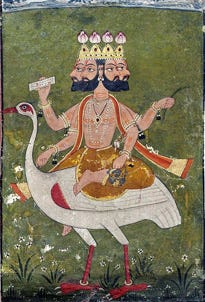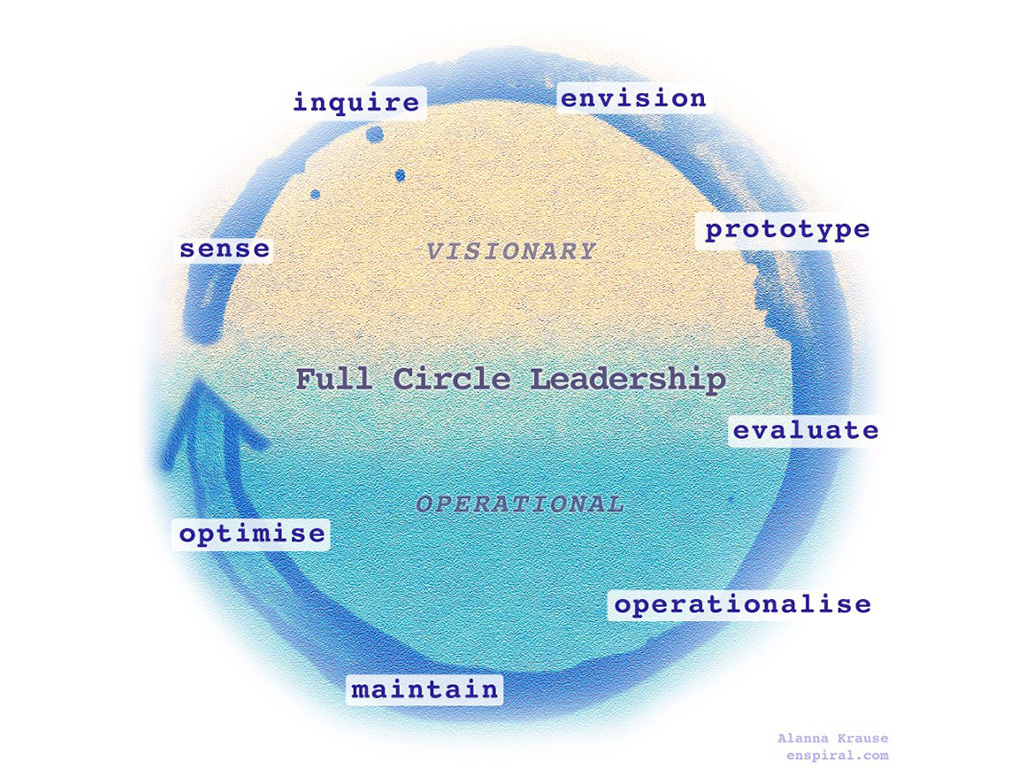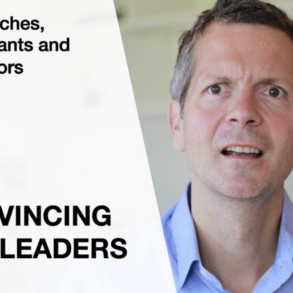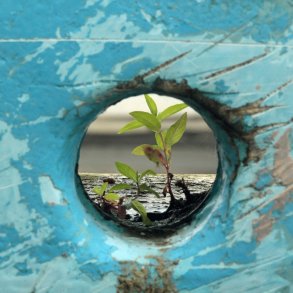By Alanna Krause and originally published on Medium
Operational leadership is often under-appreciated compared with visionary leadership, or not even understood as leadership. I used to get quite annoyed about this. But now I realise the distinction itself is a false dichotomy, caused by seeing only a narrow view of the whole leadership picture.
I remember the moment cracks in my previous mental model began to form. I was sitting on a couch at the Red Victorian in San Francisco with a friend from New Zealand. We were catching up for the first time in months, having each been on our own international journeys.
My friend is the ultimate ‘Dreamer’ — always thinking big, a million ideas a minute. This is in contrast to myself, a ‘Doer’ who jumps straight to assessing the feasibility of practical implementation. Until then, I’d seen us on two ends of a spectrum, representing conflicting approaches. Our community is full of visionaries, and I’d often felt frustrated by what I saw as unfocused hype and distraction.
But that day, my friend shared with me how challenging it is to constantly feel pressure to think big, to be the one urging people not to undershoot and miss opportunity. There was a deep calling there, a courageous optimism. He longed for a bit of structure to channel his energy, but didn’t know how to create it for himself. Similarly, I shared with him my struggles of constantly chasing after fire starters with a bucket of water, and insecurities about being too risk-averse.
Building mutual empathy caused the ends of the illusory spectrum in my mind to start bending toward one another.
Then it clicked: as a ‘dreamer’ and a ‘doer’ we weren’t on opposite ends of a spectrum. It’s not linear at all — the ends connect, in a circle forming the engine of innovation and execution.
I began writing this post about making improvements at Enspiral, a distributed network with no bosses or formal change management processes. How do new initiatives get developed and implemented ? How do ideas get integrated, bedded in — operationalised?
I wanted to talk about operational leadership, to name it and bring it into the spotlight, which is usually trained on visionary leadership. But I found I couldn’t talk about operational leadership without talking about visionary leadership, too. I had to look at the full circle.

The aspects of leadership are like avatars of a larger force.
I’m talking about bossless leadership — a force of coordinated momentum — not leadership as a given role or person. Aspects of it are often represented across a range of people with diverse perspectives and strengths. In fact, it’s rare for one person to embody all of them. That’s why we need to collaborate in balanced teams.
Different kinds of work will go through each stage in different ways, but for the engine of innovation and execution to turn over successfully, you need to go all the way around.
Below, I talk about each stage, and paint a hypothetical picture of each working well.
SENSE
The leadership of empathy
Persona: the nurturer, Measure: vulnerability, Shadow: overwhelm
You are a spider. Something small touches the far side of your web. The vibration tingles your leg.
You’ve been reading the online discussion. You went to the event and heard people talking. You brought someone a cup of tea and they shared their thinking. You’ve got feelers out. You are practicing the skills of noticing and listening.
This same topic has come up in several conversations now. Interesting.
You gossip. Gossip in your culture is about how to help people and build them up, not about cutting them down. You help create a community that is a safe space for sensitivity.
Where you thrive:
The work of listening and the skill of noticing are acknowledged, valued, and selected for. People aren’t stuck in silo’s — they can sense across the whole. Sensitivity, vulnerability, and openness are seen as strengths.
INQUIRE
The leadership of contextualisation
Persona: the facilitator, Measure: inclusion, Shadow: permission-seeking
You’ve got an inkling, an intuition, and you want to explore it. You put it out there: Has anyone else noticed this?
You’re seeing it from different angles. Who has touched this? Who has experience here? Have people worked on this before? Where did they get to last time?

You know how to identify stakeholders and go talk to them. You are a relationship builder. Your questioning is a kind of support, not an accusation or overstep.
You had some assumptions, but you’ve let them go. What you first thought to be the problem turned out to be a symptom of a larger issue. You’re seeing connections.
When you pull this thread here, that knot tightens there. Interesting.
You understand the attention economy. You hold this issue up next to others. Is it a priority right now? Do people want change? You move forward when you feel that mandate from the group.
Where you thrive:
Questioning is not taken as criticism, and past failures are shared as valuable lessons instead of being hidden away. Changing one’s mind and letting go of assumptions is seen as a sign of strength. Skilled facilitators are recognised and recruited.
ENVISION
The leadership of aspiration
Persona: the dreamer, Measure: creativity, Shadow: distraction
Something is forming in your imagination. It’s new and exciting. You’re inspired. Your creativity is flowing. You’re ideating in the shower. You’re furiously drawing maps of unknown territories.

You’ve got the courage to imagine a future that’s different, better. You are fueled by feeling the pain of the problem, but your act of creation is deeply optimistic. In your mind, you’re already living in the new reality.
Unfamiliarity and risk enlivens you. You are courageous in the face of change, even giddy. With a broad brush, you paint castles in the sky.
The hugeness of the possibility is calling to you. The gravity of the opportunity is pulling you in, and spreading beyond just you. You’re a storyteller. Your passion starts to bring others with you.
Where you thrive:
Innovation encouraged, and dynamic change is welcomed as the essence of living systems. No one will shut you down just because your thinking is unfamiliar. There space for exploration. Past failures are accepted, even celebrated, so you want to go again. You aren’t hemmed in by artificial boundaries.
PROTOTYPE
The leadership of experimentation
Persona: the hacker, Measure: efficacy, Shadow: obsession
You’ve drawn some architectural plans for your castle in the sky. The building material is now cotton, not clouds. You’ve created a scale model, so it can be engaged with and tested. It’s an MVP.
You hone in on the fastest, cheapest, most achievable way to test your key assumptions. It’s a hacked version of that off the shelf tool, or a hand drawn simulation — ugly, but functional. You’re lean and mean, knowing what not to care about yet.
You’re watching the local attention economy. Is now a good time? Are people feeling the pain this idea solves, or will it just be a distraction? In order to run a successful test, a critical mass has to be willing to engage.
You’ve shoulder-tapped some willing guinea pigs, who represent key stakeholders and personas. You’ve prepared the context, the README, the instructions. You’ve imbued the messaging with all your genuine enthusiasm for a new possibility.
Where you thrive:
Your community is open-minded, and used to trying out new things, even if they’re held together by bubblegum. If it doesn’t work at first, people cheer you on instead of punishing you. There’s enough patience and long term thinking to invest in testing and feedback before jumping straight to implementation.
EVALUATE
The leadership of measurement
Persona: the scientist, Measure: integrity, Shadow: cynicism
You show care through critical analysis. This is the moment right before things start to get expensive, before the build begins — time to make sure you’ve got it right. You are compelled to get beyond your feelings and intuitions, biases and blind spots. It has to be rigorous.
It’s a survey, or a series of interviews, or quantitative information. You do the legwork — data entry, conversations, facilitated retrospectives. You’re constantly tracking to the original purpose, the key questions, the assumptions that needed testing.
You understand how to get people to respond usefully. Your approach inspires honesty in others. You take feedback gratefully, as a sign people care. You take honesty as a sign of respect.
You have a sense for what’s signal and what’s noise in what you’re hearing. You process the feedback and make changes in response. Maybe what’s needed is a whole new prototype, or maybe just some small tweaks. You build trust with your stakeholders because they see their feedback having an impact.
Where you thrive:
In your culture, the process is emphasised more than the result. The value of iteration is well understood. Diversity is a deeply held principle, because without it testing can be skewed or biased. It’s a safe space for honesty.
OPERATIONALISE
The leadership of implementation
Persona: the negotiator, Measure: accessibility, Shadow: ruthlessness
This is the moment when something goes from a concept to part of how things are actually done. This is the work of making it real, and making it stick. You roll up your sleeves.

You have systemic awareness, combined with tangible operational knowledge. You know how the software functions, what the law is, how the machine works. There is a map in your mind of interrelationships between people, resources, regulations, culture, and strategy.
You ask some key questions: how does this new thing fit into existing processes, habits, tools, policies? Will changing this thing over here impact that thing over there? Who will need to be trained, onboarded, introduced?
You remain connected to the original intent of the change, the pain it was created to solve, but you’re not a purist. Elegant implementation is knowing how to compromise, and this is where your creativity shines.
You are problem solving as you go. How can this be implemented efficiently, to leverage what’s already here? How are we going to resource this on an ongoing basis? How should it be documented so when this person leaves, the next will know how to keep it going?
You are fiercely committed doing justice to everything that’s gone into this process up to this point. Judgement calls are required. You sense what can bend or compromise without destroying the kernel of purpose.
Where you thrive:
The cost of quality implementation is recognised and resourced as an investment. There’s no illusions that people will magically “self-organise”. Admins, coordinators, and the back office are empowered and respected. Decisions are made close where they are put in practice. You’re given mandate in the face of complexity, compromise, or resistance.
MAINTAIN
The leadership of sustaining
Persona: the captain, Measure: reliability, Shadow: bureaucracy
Staying the course means keeping focused, saying no to distractions, and following through on commitments. In non-hierarchical networks, steering happens from the rear.
You are the completer and finisher. When something new has been implemented, you grow roots through it, around it. You hold things steady, so their true effects and value can become knowable.
Holding steady is far from an inert state. It’s dynamic, a constant shifting, noticing, accommodating — like balancing. It requires deep empathy and creativity. You are in a state of mindful focus, calmly spinning plates.
It’s your soothing voice saying, “I know it’s unfamiliar. But let’s just give it a chance and see how it goes.” It’s your grounded voice saying, “We said we’d do this, so please follow through.”

You are watching the clock, keeping track of the calendar. When the time comes, you send the reminder, push the button, run the process. The link is not broken. The email has been responded to. The room has been booked. You imbue the experience with a sense of trust, patience, and reliability.
You hold stable the foundation upon which all participation can occur.
Where you thrive:
Skilled maintenance and operational reliability is acknowledged as active leadership. Visionary innovators around you understand that it is your work that makes their next exciting idea possible. There is discipline about following through on the last change before rushing into the next. Commitments are taken seriously.
OPTIMISE
The leadership of improvement
Persona: the perfectionist, Measure: commitment, Shadow: meddling
The status quo staying unchanged for too long makes you itch. You notice when a new tool or practice isn’t so new anymore. It’s been integrated and people seem comfortable with it. But ‘comfortable’ is not quite good enough.

You can see the slack bits that could be tightened. You’ve identified some blocks for removal. You want to tweak things.
Yours is a gesture of iterative looping. Perhaps it’s a small change that goes right back to maintaining. Maybe it’s circling all the way back to prototyping.
With the courage to let go of the old and welcome new possibilities, you are listening, empathising, sensing. Having journeyed all the way around the circle, you’re coming right back to the beginning — it’s your moment to start the cycle again.
Where you thrive:
In your environment, everything is up for questioning and improvement. Systems are modular, not so complex that everything is gridlocked. Inertia is not destiny. Agitating for proactive change is understood as a sign of loyalty, not undermining. Politics and egos can be cleared away to make space for innovation.
Having come all the way around the circle, you find that the final step — optimisation — is quite close to the first step — sensing. In fact, it leads right into it.
The cycle makes collective memory possible. If you don’t go full circle, it’s very difficult to build on what’s come before — like trying to construct on quicksand.

When there is an operational foundation on which to build, visionary innovation can flourish. Distributed leadership happens when different people with new ideas can pick up where others left off. This is the engine innovation and execution, of evolution and growth.
Wisdom is not mindlessly going around, but consciously seeing the layers of intersecting small and large loops in process, and choosing accordingly. Sometimes the wisest course is to hold at “maintain”. Often, one loop pauses because it’s revealed the need for another to commence. Other times it’s best to gracefully bring an avenue to completion and allow it end.
As long as a network is alive — growing and changing — the cycle keeps going.
Balancing the Circle
Diversity and balance are the keys to a healthy full circle leadership culture. Different people are strong in different areas, and are oriented to regard different parts of the cycle as important. Often it’s these very differences that create the power of the engine, with complementary forces causing it to spin.
As someone who is strongest around the operational side, I probably need to collaborate with visionaries to do my best work. Another friend who looked at the circle noted that he and his best collaborator are each strong on every other step, which is what makes their working relationship productive.
If a certain kind of leadership is unseen and undervalued in a given culture, people who excel in that area will not be able to work to their strengths, and others will miss being balanced out by their complements. Ultimately, the whole will suffer.
Developing full circle leadership means helping people and teams grow competency across the circle. The more people who feel confident that they can play their part in bringing changes through the entire process, the more real agency is distributed.
Some questions to prompt further thinking….
- Where do you see yourself as strong and weak around the circle? Does rating yourself in this way reveal anything about where you might do your best work, or where you might like to develop your leadership?
- Our vision of leadership is often skewed by our own lens. Think about the aspects of leadership that are most challenging or unattractive to you. Are you truly seeing those areas as leadership and people who excel at them as leaders?
- Consider your team or organisation as a whole. In which area do you tend to collectively excel? Is there a place in the circle where your initiatives tend to fall over? For some it will be the courage to innovate, for others the discipline to implement. What kind of leadership do you need to recruit or develop in your team to be balanced?
- Do you tend to get stuck loop in one area? For example, the entrepreneur with a “great idea” who spends years oscillating between sense, inquire, and envision, never building anything. Or the established institution stuck at maintain. What might help push through to the next stage?
In future articles, we’ll explore some specific examples from my experiences journeying around the circle at Enspiral, and further thinking about developing the model.





This is so helpful, Alanna. It gives me a new way of relating to leadership. There are so many useful hand-holds and foot-holds here. Because it is written in the second-person, it lets me step into each leadership type, try it on like a set of clothes, and see if it fits. It also gives me a frame for understanding why my leadership strengths might be resisted in a particular organization or when they might be out of or in sync. In this way, I can become more skillful.